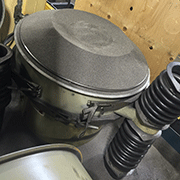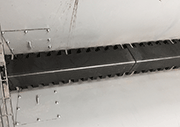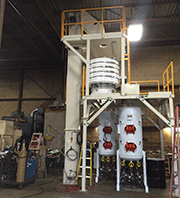E-Archive
Articles
in Vol. 19 - January Issue - Year 2018
Strategic Operation & Maintenance for Repeatable Shot Peening

Example of a plugged classifier screen leading to accumulation of abrasive on the screen

A metering cover as shown in picture constantly regulates media flow into the reclaim system and prevents overloading

A dual media machine is best designed with dedicated blast tank for each media size in use

Safety measures including those provided to protect personnel from moving parts should never be bypassed
Introduction
Stringent maintenance requirements imposed by blast cleaning and shot peening machines are well-known in the industry. Even better known are the repercussions when users fail to perform such routine and preventative maintenance on their equipment! The popular belief is that heavy-duty cleaning applications, such as in foundries and forge shops are harder on their blast equipment, and that their maintenance assumes greater importance than for instance, peening aerospace components. Though it is true that the machines see greater wear in foundries and forge plants, maintenance is equally important in lighter-duty applications as well. The accuracy and repeatability of aerospace peening projects are very critical and carry high liability through the end-product. In both cases, the user is dealing with a metallic component that’s being bombarded with ferrous or non-ferrous blast media. There are several moving parts, wear items, setpoints, calibration requirements and so on to contend with. The discussion here will focus on air type shot peening equipment, with an effort to identify critical maintenance points for the shot peener to be proactive about.
Media Reclaim System
The common joke within the industry is that one can expect their machine to have no operational issues unless charged with blast media! Moving away from that utopia, a practical means to assess the maintenance requirements of a cleaning or peening machine is by following the path of the blast media. After being propelled from a blast nozzle or wheel, the media discharges into the reclaim system. Media reclaim could be mechanical or vacuum style, with the former utilizing a belt and bucket elevator and the latter using vacuum through a reclaim duct and cyclone separator. Mechanical reclaim systems are generally considered workhorses and employed when peening with large quantities of ferrous media. Though they do require routine maintenance, their setting and calibration requirements are relatively infrequent. Vacuum reclaim systems, on the other hand, are sensitive to use. The media reclaim duct will not be as effective if demand is made for a single heavy load of media to be sucked in to the system. In other words, when charging new media, it is advisable to do so regularly, and in small quantities rather than all at once. Automatic media adders are very effective in metering this operation. This practice is very relevant in peening where constant media size is important for accurate results. A mix of media sizes, which is a possible outcome of irregular media additions, is not a desirable property for accurate shot peening results.
Velocity setting inside the cyclone is a factor in determining the reclaim efficiency. Some designs incorporate a tuning cone, which is factory-set for a given media size. Though this setting doesn’t require changing, it needs to be checked periodically by inspection of the dust collector waste stream for good, useable media. Good media in the waste stream is indicative of a high reclaim velocity, and broken/fines mixed with good media in the blast stream signifies lower than optimum velocity in the cyclone. Neither condition is acceptable in the maintenance of constant media size for shot peening.
Media Size Classification
As the useable media separated by the cyclone travels along, it discharges into the vibratory classifier for size classification. Screen opening size is as directed by the relevant specifications. A torn or plugged screen can cause as much damage as not having a classifier in the peening system. A screen could plug for the following two reasons – (a) clumping of non-ferrous peening media such as glass bead and ceramic due to atmospheric humidity or presence of moisture in the compressed air line, and (b) broken, sharp particles of media getting firmly lodged in the screen holes, unable to release themselves. A tear in the screen (typically in the top screen) is mainly due to FOD (foreign object damage). Inspection of the screens is the only effective way to be made aware of either issue. Plugging of the screens can be mitigated by installing an OEM supplied ball tray that bounces below the screen openings, constantly unplugging the screen holes. The symptoms of these issues are – good media in the classifier trash pail points to a plugged screen. Similarly, foreign objects that are larger in size than the nominal size of media that are found mixed in with the useable media in the storage hopper or blast tank indicate a tear in the screen. In the worst case, this large-sized contaminant could result in a plugged tank valve or blast nozzle. In a wheelblast machine, this could even lead to a shattered blade in a blast wheel rotating at speeds as high as 3600 RPM – leading to a potentially dangerous outcome.
Some points to consider:
• Respect the capacity of the classifier to handle media, and do not overload it.
• Nothing can replace regular inspection
• As mundane as it sounds, the trash drums at the dust collector, classifier and airwash separator (in a mechanical reclaim system), will reveal the health of the reclaim system. Pay attention to all discharge points and collections.
Though part of the ventilation and dust collection system, the dust collector is also the final point in a vacuum reclaim system. This discussion will not focus much on the collector itself, but point towards some key aspects of collector inspection:
• Absence of dust in the collector drum is not good news. This could mean that the ventilated dust has settled along the duct length, or in the drop-out box, if it is provided in the system. If not inspected regularly and cleared, continued accumulation of dust could lead to it capsizing on an unsuspecting person directly underneath the duct.
Media flow control
Provision needs to be made for dismantling the flow control valve for repair, routine maintenance or factory calibration. In certain piping designs, the flow control valve is attached to the outlet without a shut-off valve directly above it. Such an arrangement makes it very difficult to remove the flow control valve during maintenance. Also, constant media presence in the piping will lead to erroneous display of media flow rate through the valve during the start of a cycle.
Dual media machines
Dual media machines could be configured with two media sizes or two media types, involving ferrous and non-ferrous media. In both cases, it is important to establish a proper procedure when changing over from one type to the other. Some points of caution:
• Dual media machines that propose to work with media sizes close to the other (ex. S70 and S110) are not effective because of the challenge in separating them (screening tolerance is very close). If this is an unavoidable situation, it’s advisable to use two separate classifiers, each dedicated to one size, with an upstream valve to divert the streams.
• It is ideal to have a one-size gap between the two sizes being classified (i.e. S110 and S230).
• Drum type magnetic separators are effective for separation of ferrous and non-ferrous media in the same machine.
• When using different media types and sizes in the machine, it is advisable to dedicate a blast tank to each individual size/type of media.
• Flush the blast hose with compressed air after every change.
When peening with multiple media types and sizes in a common machine, users sometimes economize by:
• Using a common blast tank - drain the tank during changeover and fill it with the new media size
• Using a common classifier and change the screen only – care to be taken that the screen has been changed to the correct size as part of the procedure
The capital cost savings from adopting the above must be weighed carefully with the inherent risks of missing a step, and the ensuing labor required to physically cleanout the cabinet between every change in size/type.
Pressure monitoring and control
Velocity of peening media is directly proportional to the intensity and resulting residual compressive stress. Maintaining constant velocity throughout the cycle is paramount in shot peening, and that requires establishing a reliable source of compressed air. Unless an air compressor can be dedicated to the shot peening machine, and its installation is in close proximity to the machine, it's advisable to locate an air receiver immediately next to the machine. This assures a steady volume/supply of compressed air delivered at a constant pressure.
The air receiver also helps in eliminating entrained moisture from the compressed air before feeding the blast tank. Even though compressors may be provided with air dryers, if the unit is located at a long distance from the machine, condensate formation in the airline could transfer moisture to the blast tank in the absence of a receiver.
As can be seen from the above discussions, maintaining the quality of peening media and compressed air play a major role in the effectiveness of a shot peening operation. Listed below are other aspects of maintenance that should not be ignored:
1. Blast nozzles wear at a rate dependent on the nozzle material, media type, air pressure (velocity) etc. A nozzle is considered worn when the original bore size increases between 1/16” and 1/8”. Any further use will alter peening results. Use of a calibrated dowel is recommended when measuring nozzle bore for wear.
a. A plugged nozzle should never be tapped against a hard surface to clear the blockage. Nozzle materials are brittle, and any sharp impact will shatter it.
2. Blast hoses should be routed to minimize the number of sharp bends. Sharp bends reduce the line pressure at discharge and also lead to premature hose wear, both of which could affect peening results. When connected to a traveling nozzle carriage, blast hoses should be routed and fitted so that they don’t rub against any machine part and cause wear.
3. Vibration in a blast machine is common and accommodation should be made to inspect and rectify any shift in the location of electronic sensors and switches. For example, a proximity sensor on a loose bracket, dislocated due to normal vibration will send an incorrect locational signal to the PLC, resulting in faulty motion of the nozzle and incorrect area being peened.
4. Though not directly connected to the peening results, safety measures in a peening machine should never be bypassed. Compressed air, unless used carefully, could be lethal. All components using compressed air should be isolated from the source before performing any maintenance work. All moving parts of the shot peening machine such as nozzle holding brackets and robotic arms should be protected by guards and safety fences.
Summary
Shot peening is a dynamic operation and no discussion can completely cover all aspects of critical maintenance. This discussion is intended to bring up points that have a direct impact on the peening results. If media addition in a peening machine is sporadic, the machine will not be able to maintain a consistent media size, leading to misleading peening results. The reclaim system is typically built to handle a finite amount of media per hour. Loading up the system all at once will clog it, interrupt the reclaim and starve the system of recycled media – leading to an interruption of the peening cycle. Size classification if not done right will show up in the saturation curve as an undesirable double-knee due to a mixture of sizes. This in turn will transfer uneven residual compressive stress on to the component being peened.
Blast cleaning and peening machine maintenance is one of the most difficult, trying and challenging occupations in the industry. Knowing the areas to focus on, and the repercussions of failing to do so, help the user devote suitable resources to this task. Shot peening is a critical operation, with far-reaching implications if not done right, and major benefits when conducted with care. The choice rests with the user.
For Information:
Langtry Blast Technologies Inc
5390 Munro Court, Burlington
Ontario, L7L 5N8, Canada
Tel. +1.905.681 2030
Fax +1.905.681 2814
E-mail: info@blastech.org
www.blastech.org




























